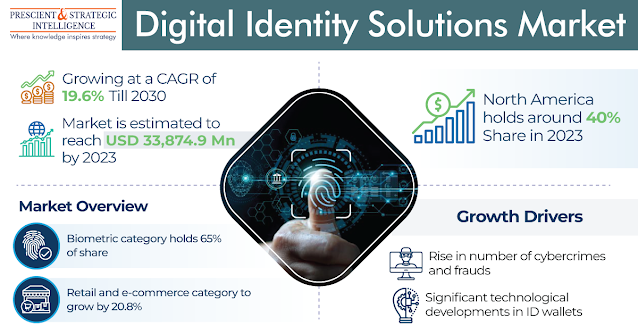According to the latest market research study published by
P&S Intelligence, the U.S. enterprise resource planning software market
is on a significant growth trajectory, with a projected expansion from USD 12.6
billion in 2024 to USD 16.8 billion by 2032, exhibiting a Compound Annual
Growth Rate (CAGR) of 3.7%. This growth is attributed to the increasing demand
from businesses seeking to streamline operations, improve efficiency, and
support data-driven decision-making. ERP software helps organizations manage
and automate various business functions, such as finance, supply chain,
inventory management, and human resources, in a unified system.
One of the key factors driving the market’s growth is the
ongoing digital transformation across industries. As businesses continue to
adopt advanced technologies, ERP solutions have evolved to incorporate
cutting-edge features like artificial intelligence (AI), machine learning, and
the Internet of Things (IoT). These advancements enhance the functionality of
ERP systems, enabling businesses to make real-time decisions and gain
predictive insights, thus optimizing their operations.
Additionally, cloud-based ERP systems are becoming
increasingly popular due to their ability to provide scalable, cost-effective
solutions for businesses of all sizes. Cloud ERP reduces the need for
businesses to invest heavily in on-premise infrastructure, offering the
flexibility of accessing the system remotely and minimizing upfront costs.
This, combined with the growing trend toward remote and hybrid work
environments, has driven the adoption of cloud ERP systems, particularly among
small and medium-sized businesses (SMBs).
Furthermore, the demand for ERP systems is also supported by
regulatory requirements and compliance mandates in industries such as
healthcare, manufacturing, and finance. ERP systems help organizations adhere
to these regulations while ensuring efficient management of their day-to-day
operations. As these industries continue to face pressure to meet compliance
standards, the role of ERP software becomes even more critical.
Key Insights
Segmentation Analysis
Deployment Type
On-premises ERP solutions currently hold the largest market
share due to their adoption by large enterprises in industries such as
manufacturing and finance, where regulatory requirements and security concerns
demand more control over systems. However, cloud-based ERP systems are the
fastest-growing segment, expected to dominate the market by 2032 due to their
flexibility, lower initial investment, and ease of scalability. Cloud ERP
systems are particularly favored by small and medium-sized businesses looking
for affordable and efficient solutions.
Function-Specific Adoption
The finance function remains the dominant area of ERP
adoption, primarily driven by the need for robust financial management,
compliance, and reporting features. The ability to automate financial
processes, such as payroll, invoicing, and budgeting, is a major factor in the
widespread use of ERP systems in the finance department. The supply chain
management function is another area seeing significant growth, driven by the
need for real-time tracking, optimization, and visibility across the entire
supply chain. ERP systems help businesses reduce operational costs, improve
procurement efficiency, and manage inventory better.
Regional and Geographical Trends
The U.S. ERP market shows distinct regional variations. The
Western U.S. remains the largest market for ERP software, with major tech hubs
like California and Washington driving adoption. This region is home to several
large technology firms that benefit from advanced ERP solutions for their
global operations. On the other hand, the Southern U.S. is experiencing the
highest growth rate, with businesses in this region increasingly adopting
cloud-based ERP systems to address the needs of small and medium-sized
enterprises (SMEs).
Other regional drivers include the Midwest and Northeast,
where manufacturing and retail sectors are ramping up ERP system
implementations to address complex supply chain and logistics challenges.
Technological Advancements
AI and machine learning integration within ERP systems are
enabling organizations to automate routine tasks, enhance data analytics, and
improve decision-making. Predictive analytics, powered by AI, help businesses
forecast demand, optimize inventory levels, and make better procurement
decisions. Additionally, the integration of IoT with ERP systems enables
real-time data collection from connected devices, improving efficiency in
manufacturing, logistics, and asset management.
Other advancements in ERP technology include mobile ERP
solutions, which provide users with the flexibility to access critical business
data remotely. As more companies embrace remote and hybrid working models, the
demand for mobile ERP solutions has increased, enabling employees to stay
connected and make decisions on the go.
Competitive Dynamics
The U.S. ERP market is highly competitive, with both
established ERP vendors and emerging companies vying for market share. Leading
players in the market include SAP, Oracle, Microsoft, and Infor, which offer
comprehensive ERP solutions that cater to a wide range of industries and
business sizes. These companies are continuously enhancing their offerings by
incorporating new features such as AI, machine learning, and IoT.
Meanwhile, smaller ERP vendors are carving out a niche by
offering specialized solutions for specific industries such as healthcare,
manufacturing, and retail. These vendors are also focusing on providing
cloud-based ERP systems, which are gaining traction among SMBs looking for
affordable solutions.
Emerging Opportunities
The healthcare industry is emerging as one of the
fastest-growing verticals for ERP adoption. Healthcare organizations are
adopting ERP solutions to streamline their operations, manage patient data
efficiently, and ensure compliance with healthcare regulations. As the
healthcare sector increasingly moves toward digital transformation, ERP systems
are becoming essential for managing everything from patient records to supply
chain operations.
The manufacturing sector remains the largest adopter of ERP
systems due to its complex operations, supply chain management needs, and
compliance requirements. The growing demand for Industry 4.0 technologies,
including smart factories and automation, is further driving the need for ERP
solutions in this sector.
The retail sector is also experiencing strong growth in ERP
adoption, as businesses require advanced solutions to manage their inventory,
track customer data, and improve overall supply chain visibility. As e-commerce
continues to rise, retailers are increasingly relying on ERP systems to stay
competitive and deliver better customer experiences.
In conclusion, the U.S. ERP Software Market is
set for continued growth, with technological advancements and shifting business
needs driving adoption across various sectors. As companies seek greater
efficiency, automation, and regulatory compliance, ERP systems will remain a
critical tool in the modern business landscape.

















